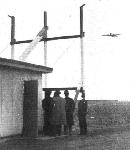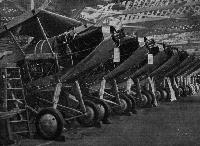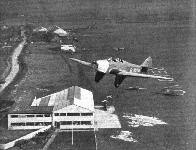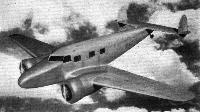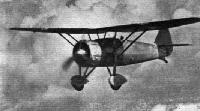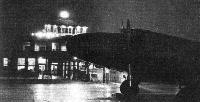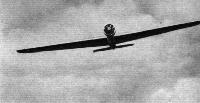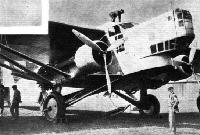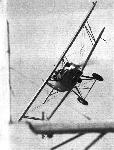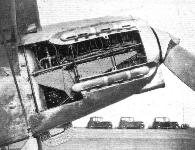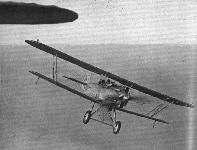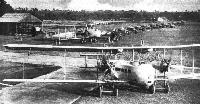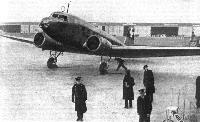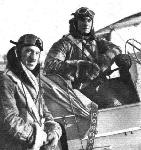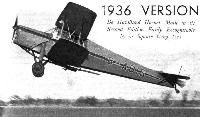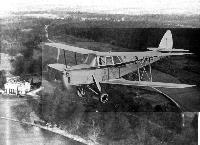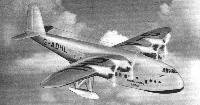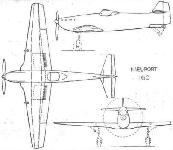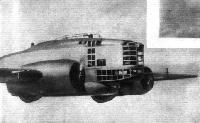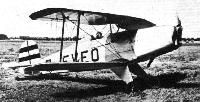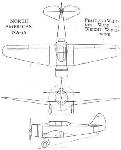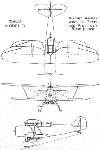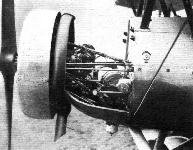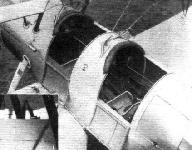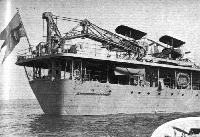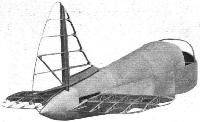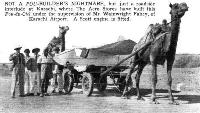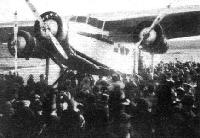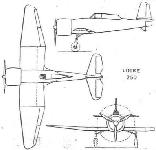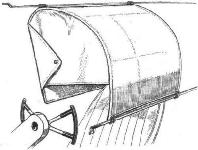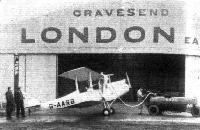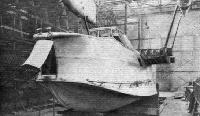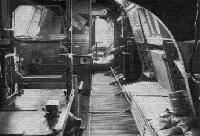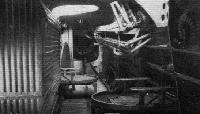Фотографии
-
Behind the main beacon at Heston: The Ju.52 is making a demonstration approach.
Самолёты на фотографии: Junkers Ju.52/3m - Германия - 1931
-
"It was rightly felt that the aircraft firms could deal with the large orders required." Hart Trainers under construction.
Самолёты на фотографии: Hawker Hart - Великобритания - 1928
-
Регистрационный номер: G-ADZD OUT AND UP: This Flight photograph, taken at Reading Aerodrome, shows Wing Comdr. F. W. Stent flying the Miles Hawk Trainer in its latest form. In the foreground are the Phillips and Powis experimental shops and in the distance are the New Reserve school and the service hangars.
Самолёты на фотографии: Miles Hawk / M.2 - Великобритания - 1932
-
Регистрационный номер: G-ADLC ODYSSEY, 1936: The Miles Falcon (Gipsy Six) in which Flt. Lt. T. Rose handsomely lowered the England-Cape record; this Flight photograph was taken during a final test on the day before the successful attempt started.
Самолёты на фотографии: Miles Falcon M.3 / Hawcon M.6 - Великобритания - 1934
-
STAR-DUST: That the Lockheed Model 12 is descended from the Electra is readily apparent here.
Самолёты на фотографии: Lockheed Electra Junior 12 - США - 1936
-
The distinctive outline of the big Amiot 142 (two Mistral Majors) is apparent here.
Самолёты на фотографии: Amiot Amiot 140 / Amiot 143BN5 - Франция - 1931
-
This is the Marcel Bloch 200 (two Mistral Majors) which is now in everyday use. It does about 180 m.p.h. A number of French firms are building this machine under licence for the French Government.
Самолёты на фотографии: Bloch MB.200 - Франция - 1933
-
The Dewoitine D.371 single-seater is being supplied to the French Navy as a fleet fighter and to Lithuania. Its Mistral Major gives a speed of 235 m.p.h. Two canons may be carried.
Самолёты на фотографии: Dewoitine D.37 - Франция - 1932
-
NOCTURNE: One of the United Air Lines' Boeing 247 's in front of the terminal buildings at Burbank Airport, California - which is generally considered to be America's model airport.
Самолёты на фотографии: Boeing Model 247 - США - 1933
-
Регистрационный номер: K5200 OUTSTANDING MILITARY TYPE. The Gloster Gladiator is the first four-gun single-seater to be adopted, and does 260 m.p.h. at 15,500 ft. with a 715 h.p. Mercury VIII.
Самолёты на фотографии: Gloster Gladiator - Великобритания - 1934
-
The Vickers "Wellesley" medium bomber (Pegasus XVIII), in which the famous geodetic construction system is employed, is another type for which a considerable order has been placed.
Самолёты на фотографии: Vickers Wellesley - Великобритания - 1935
-
GAUDY RAIDERS: Italian Savoia Marchetti S.81 bombers of the type which is being used in increasing numbers in Abyssinia. The S.81 may be regarded as a military version of the S.73 used by Sabena.
Самолёты на фотографии: Savoia-Marchetti / SIAI SM.81 Pipistrello - Италия - 1935
-
The 3,600 h.p. Farman F-221 is a champion weight lifter with four Mistral Majors. In a later form it is being built for the French Air Service.
Самолёты на фотографии: Farman F.220 / F.221 / F.222 - Франция - 1932
-
Fitted with the French Gnome-Rhone Mistral Major fourteen-cylinder radial of 870 h.p., this Belgian Renard R-32 observation monoplane - which also functions at will as a two-seater fighter or light bomber - has a maximum speed of 230 m.p.h at 13,120 ft. It stalls at 59 m.p.h., has a service ceiling of over 37,000 feet and a range of 800 miles. Its somewhat peculiar wing is said to show interesting characteristics on climb and during a landing: the machine will reach 16,400 ft. in 7 minutes. A notable feature is the cockpit enclosure.
Самолёты на фотографии: Renard R.31 / R.32 - Бельгия - 1932
-
Регистрационный номер: K3719 [3] Another view of the prototype Hawker Hector army co-operation machine with the Napier-Halford Dagger III moderately supercharged 24-cylinder air-cooled engine, which is rated at 725 h.p. and gives a maximum of 805 h.p. at 4,000 r.p.m., and 5,000 feet. It achieves something like 200 m.p.h. The top wing has no sweepback (the installation of the Dagger moved the C.G. forward) and a cut-away gunner's position is incorporated.
Самолёты на фотографии: Hawker Hector - Великобритания - 1936
-
Регистрационный номер: K3719 [3] GUARDIAN ANGEL TO THE INFANTRY: The newest Army Co-operation aeroplane to be adopted by the R.A.F. is the Hawker Hector with Napier-Halford Dagger III 24-cylinder air cooled engine.
Самолёты на фотографии: Hawker Hector - Великобритания - 1936
-
THRUST: In this view of the Napier-Halford Dagger III engine in the Hawker Hector, the sturdy bearers and the uncommon exhaust arrangements are visible. The Dagger III has 24 cylinders and develops a maximum of 805 h.p.
Самолёты на фотографии: Hawker Hector - Великобритания - 1936
-
Регистрационный номер: K3719 [3] THE NEW HAWKER HECTOR army co-operation biplane in the hands of Mr. P. Lucas breaks formation with the evergreen "-MR" flown by Mr. Hindmarsh and carrying Flight's photographer.
Самолёты на фотографии: Hawker Hector - Великобритания - 1936
-
MILITARY AND CIVIL: Singapores, Scapas and an Imperial Airways Calcutta off the Khedival Palace, Alexandria.
Самолёты на фотографии: Short Calcutta / Rangoon / S.8 - Великобритания - 1928Short Singapore III / S.19 - Великобритания - 1934Supermarine Scapa - Великобритания - 1932
-
THE BAGGAGE TRAIN Two Vickers Valentias carried the equipment of this Hart squadron on its flight from Risalpur to Singapore and back. Here they are seen at Dum Dura, near Calcutta.
Самолёты на фотографии: Vickers Valentia - Великобритания - 1934
-
When accurate navigation is necessary: A sea of cloud laps against the Alps; Basle lies below it.
Самолёты на фотографии: Douglas DC-1 / DC-2 / C-32 / C-39 - США - 1933
-
The Douglas on the tarmac in front of the terminal building at Zurich - an example of clean and "obstruction-free" design which might be copied elsewhere.
Самолёты на фотографии: Douglas DC-1 / DC-2 / C-32 / C-39 - США - 1933
-
Waiting for permission to leave the tarmac at Croydon. The loop aerial can be seen above the control cabin as well as the oiled leather-coated spinners for ice protection.
Самолёты на фотографии: Douglas DC-1 / DC-2 / C-32 / C-39 - США - 1933
-
Overhauling one of the five Swissair Douglas machines in the Zurich shops, which are kept scrupulously clean and must be among the most up to date in Europe.
Самолёты на фотографии: Douglas DC-1 / DC-2 / C-32 / C-39 - США - 1933
-
The Sperry in charge,at 9,000 ft. over Rheims, while the pilot, Mr. Nieffenegger, looks on before returning to his charts.
Самолёты на фотографии: Douglas DC-1 / DC-2 / C-32 / C-39 - США - 1933
-
Регистрационный номер: G-ADWM RESERVE TRAINING IN SCOTLAND: The photograph shows a line-up of D.H. Tiger Moths outside the new Reserve School which, established by Scottish Aviation Ltd., at Prestwick, near Ayr, started flying operations last Monday. The hangar accommodates twenty-five machines, and the administrative block contains lecture rooms, armament and photographic sections, parachute room and instructors' and pupils' quarters. The directors of the company are Mr. W. E. Nixon, Lord G. N. Douglas-Hamilton, Flt. Lt. D. F. McIntyre (who served as second pilot on the Everest expedition, and who is chief instructor) and Messrs. R. L. Angus and T. P. Mills. Eight flying instructors and a ground instructor are engaged.
Самолёты на фотографии: De Havilland Tiger Moth / D.H.82 - Великобритания - 1931
-
This is probably the first photograph ever taken of a machine on its back with the pilot - in this case Flt. Lt. H. A. Howes - by himself and under the hood.
Самолёты на фотографии: De Havilland Tiger Moth / D.H.82 - Великобритания - 1931
-
The conspirators between acts: Mr. G. E. Lowdell and Flt. Lt. H. A. Howes snapped a moment before the latter took off to "pose" for the next picture.
Самолёты на фотографии: De Havilland Tiger Moth / D.H.82 - Великобритания - 1931
-
Регистрационный номер: G-ADUG FOR IMPERIAL SERVICE: The first of the new D.H. 86A's which are being built for Imperial Airways. machines are not fitted with v.p. airscrews.
Самолёты на фотографии: De Havilland Express Air Liner / D.H.86 - Великобритания - 1934
-
The party which made British Airways, Ltd., survey flight in a D.H.89, photographed at Malmo. The group includes Flt. Lt. W. F. Anderson, chief pilot (third from right), Sqn. Ldr. E. H. D. Spence, R.A.F.O., of the Air Ministry technical department (fourth from right) and Mrs. Spence.
Самолёты на фотографии: De Havilland Express Air Liner / D.H.86 - Великобритания - 1934
-
A snapshot taken at Amsterdam on the British Continental Airways inaugural flight. Leaving the machine is Mr. D. A. Adkins and in the group, left to right, are Messrs. J. R. Bryans, F. W. Jones, M. C. Bryans and W. K. Bear.
Самолёты на фотографии: De Havilland Express Air Liner / D.H.86 - Великобритания - 1934
-
Регистрационный номер: G-ADIS [3], G-ADKR THE OLD ORDER CHANGETH: This photograph affords an interesting comparison between the 1935 and 1936 versions of the de Havilland Hornet Moth.
Самолёты на фотографии: De Havilland Hornet Moth / D.H.87 - Великобритания - 1934
-
Регистрационный номер: G-ADIS [3] Comfort and good view in all essential directions are features of the 1936 Hornet Moth, which, with side-by-side seating is equally suitable for touring and tuition. With a 130 h.p. Gipsy Major engine, the maximum speed is about 124 m.p.h. and the cruising speed 103-108 m.p.h., according to the degree of throttling.
Самолёты на фотографии: De Havilland Hornet Moth / D.H.87 - Великобритания - 1934
-
Регистрационный номер: G-ADIS [3] The D.H. "Hornet Moth" Two-seat Light Cabin biplane (130 h.p. D.H. "Gipsy-Major" engine).
The attractive aerial view was "posed" for Flight's photographer by Mr. H. Buckingham of the De Havilland Company.Самолёты на фотографии: De Havilland Hornet Moth / D.H.87 - Великобритания - 1934
-
On the stocks. A view in the Rochester works, showing hulls 1 to 5.
Самолёты на фотографии: Short Empire / S.23 - Великобритания - 1936
-
The engine nacelles for boat No. 1 nearly completed, with others in jigs. The details of the wing construction are somewhat similar to those tried out in the Short Scion.
Самолёты на фотографии: Short Empire / S.23 - Великобритания - 1936
-
The frame in way of rear spar is shown on the left. Note the straight sides and small beam-depth ratio. On the right, a view inside the hull of boat No. I, looking aft.
Самолёты на фотографии: Short Empire / S.23 - Великобритания - 1936
-
A view of the cantilever tail
Самолёты на фотографии: Short Empire / S.23 - Великобритания - 1936
-
The "box " section wing spar of one of the first boats in course of construction.
Самолёты на фотографии: Short Empire / S.23 - Великобритания - 1936
-
Cylindrical petrol and oil tanks. Note the baffle plates, and the numerous tie rods which brace the tank ends.
Самолёты на фотографии: Short Empire / S.23 - Великобритания - 1936
-
IMPERIAL LUXURY: The after cabin of one of the new Short "Empire" flying boats, seen from the promenade cabin. For night work, bunks will be rigged above the luxurious seats - which, it will be noted, are provided with adjusting levers to set the backs to any desired angle. By day the boat will carry 24 passengers, and 16 by night - which suggests even more intricate booking problems for the Imperial Airways traffic staff. This photograph, of course, is not of the interior of an actual boat, but of the careful "mock-up" which serves as a guide to the fitting-out of the finished article.
Самолёты на фотографии: Short Empire / S.23 - Великобритания - 1936
-
Регистрационный номер: G-ADHL [2] The new "big stuff'' represented by models. The Short Empire flying boat
Самолёты на фотографии: Short Empire / S.23 - Великобритания - 1936
-
Регистрационный номер: G-ADHL [2] ON THE MEDWAY SOON: A new composite picture showing how a flying boat of our new Short Empire class will appear. Notice how, with the reduction in span, the outboard engines are neating the wing tips. These engines are likely to be 820 h.p. Pegasus Xs and will drive D.H.Hamilton airscrews.
Самолёты на фотографии: Short Empire / S.23 - Великобритания - 1936
-
Nieuport 160
Самолёты на фотографии: Loire-Nieuport LN 160/161 - Франция - 1935
-
A real flying citadel: the Breguet 460-M5 multi-seater is estimated to do 239 m.p.h. at over 13,000 ft. with a pair of 900 h.p. Gnome Rhone Mistral Majors
Самолёты на фотографии: Breguet Br.460 Vultur - Франция - 1935
-
Регистрационный номер: D-EVEO SOLO TRAINER: A climb of 3,280 ft. in 3 min. and a top speed of 142 m.p.h. are achieved by this new German single-seater trainer, the Bucker Bu.133. The engine is a 140 h.p. Hirth.
Самолёты на фотографии: Bucker Bu.133 Jungmeister - Германия - 1935
-
NORTH AMERICAN NA-16. PRATT AND WHITNEY WASP OR WRIGHT WHIRLWIND
Самолёты на фотографии: North American BT-9/NJ/NA-16, -19, -28 - США - 1935
-
WACO MODEL D. WRIGHT WHIRLWIND OR PRATT AND WHITNEY WASP JUNIOR
Самолёты на фотографии: WACO D Series - США - 1933
-
Регистрационный номер: G-ADJT In external appearance the 643 Mk.II resembles the ordinary staggered Cadet. The re-arrangement of the bracing wires is visible in this view.
Самолёты на фотографии: Avro Cadet / Type 631/643 - Великобритания - 1932
-
The grouping of the accessories behind the engine and the ease of access to them for maintenance purposes is visible here. Note the oil cooler.
Самолёты на фотографии: Avro Cadet / Type 631/643 - Великобритания - 1932
-
Ease of exit by parachute is desirable in a training aeroplane and is not lacking in the new Cadet. This view shows also the capacious luggage locker.
Самолёты на фотографии: Avro Cadet / Type 631/643 - Великобритания - 1932
-
Регистрационный номер: G-AAGX Sharjah, Oman, on the Persian Gulf, a desert station on the Empire route. This view is from one of the fine dioramas at the recent Imperial Airways Exhibition.
Самолёты на фотографии: Handley Page H.P.42 / H.P.45 - Великобритания - 1930
-
Members of the crew of the Swedish aircraft carrier Gotland pose for Flight beneath their Ospreys.
Самолёты на фотографии: Hawker Osprey - Великобритания - 1930
-
The stern of the Gotland is of somewhat unusual formation. This view shows the crane and the two folded Ospreys.
Самолёты на фотографии: Hawker Osprey - Великобритания - 1930
-
This picture indicates the length of deck occupied by the aeroplane tracks and the catapult.
Самолёты на фотографии: Hawker Osprey - Великобритания - 1930
-
PAROCHIAL TRANSPORT: This is the Rev. Father J. M. Coulture who tends the needs of his flock by air. The machine is a ski-equipped Aeronca. on which the "sky pilot" owner has covered many thousand miles.
Самолёты на фотографии: Aeronca C - США - 1929
-
Регистрационный номер: K7557 The prototype Bristol 142 (two 605 h.p. Mercury VI) from which a medium bomber is being developed.
Самолёты на фотографии: Bristol Type 142 Britain First / Type 143 - Великобритания - 1935
-
The semi-monocoque fuselage and tail unit of the Marendaz monoplane.
Самолёты на фотографии: Marendaz Mk III - Великобритания - 1937
-
MARENDAZ MONOPLANE
Самолёты на фотографии: Marendaz Mk III - Великобритания - 1937
-
NOT A POU-BUILDER'S NIGHTMARE, but just a roadside interlude at Karachi, where The Aero Stores have built this Pou-du-Ciel under the supervision of Mr. Wainwright Fahey, of Karachi Airport. A Scott engine is fitted.
Самолёты на фотографии: Mignet Pou-de-Ciel / HM-14 - Франция - 1932
-
ACCLAMATION: Crilly Airways' Fokker F.12, Lisboa, surrounded by an interested crowd at Lisbon after the inaugural flight. A daily service will be started as soon as the aerodromes are really fit for use after the heavy rains.
Самолёты на фотографии: Fokker F.IX / F.XII / F.XVIII - Нидерланды - 1929
-
Loire 250
Самолёты на фотографии: Loire Loire 250 - Франция - 1935
-
The new Miles Nighthawk has an ingenious arrangement of hoods by which the pupil is prevented from seeing the horizon, although he can see, and fly by, the instruments fitted to the dash. The instructor retains a very wide angle of view. In the spring the Nighthawk will become available as a luxurious four-seater.
Самолёты на фотографии: Miles Nighthawk M.7 / Mentor M.16 - Великобритания - 1935
-
The doors of the Nighthawk are designed with a view to quick exit in an emergency.
Самолёты на фотографии: Miles Nighthawk M.7 / Mentor M.16 - Великобритания - 1935
-
SPIN-STOPPING BY PARACHUTE: Mr. F. G. Miles has evolved a scheme, not yet tested in actual flight, for stopping a flat spin during the flight-testing of new aircraft by releasing a small parachute anchored to the tail of the machine. In this picture the parachute is being fitted on a Nighthawk.
Самолёты на фотографии: Miles Nighthawk M.7 / Mentor M.16 - Великобритания - 1935
-
This is the prototype Nighthawk, with a Gipsy Six engine, prior to being tested by Mr. Miles.
Самолёты на фотографии: Miles Nighthawk M.7 / Mentor M.16 - Великобритания - 1935
-
The duplication of the instruments, the layout of the swing-over controls and the method of screening a pupil are all apparent in this sketch. The hood slides on rails.
Самолёты на фотографии: Miles Nighthawk M.7 / Mentor M.16 - Великобритания - 1935
-
This Flight sketch shows the hood which can be unbuttoned and slid back.
Самолёты на фотографии: Miles Nighthawk M.7 / Mentor M.16 - Великобритания - 1935
-
Регистрационный номер: G-AARB PERSONALITIES AND PETROL AT GRAVESEND: The aeroplane in this photograph, seen standing in front of the big hangar (erected by A. and A. J. Law, Ltd.) at Gravesend Airport, is the metal Moth which Miss Jean Batten flew to Australia, and which now belongs tor Mr. Michael Sassoon, who keeps it at Gravesend. It is being refuelled from a T.B. 250-gallon portable unit which Airworthiness, Ltd., have found " to prove worth its weight in gold." In the left foreground are Mr. Garnon, the local Esso representative and Mr. H. C. Brown, manager of Airworthiness Ltd. The Airworthiness workshops are stated to be very busy, while the students of the Company's engineering school are now designing an aeroplane of their own.
Самолёты на фотографии: De Havilland Gipsy Moth / Moth X - Великобритания - 1928
-
Регистрационный номер: S1648 Самолёты на фотографии: Supermarine Scapa - Великобритания - 1932
-
A Scapa engine nacelle. In this view the nacelle has been placed on its side in order to show the inspection doors in the floor by which engineers reach the engines. The nacelle is of all-metal construction.
Самолёты на фотографии: Supermarine Scapa - Великобритания - 1932
-
The photograph forms an interesting companion to the sketch on the previous page in that it shows the special ribs in the wing root. These ribs are of channel section.
Самолёты на фотографии: Supermarine Scapa - Великобритания - 1932
-
A view of the hull, with wing roots in place.
Самолёты на фотографии: Supermarine Scapa - Великобритания - 1932
-
Interior of the Scapa looking towards the bows
Самолёты на фотографии: Supermarine Scapa - Великобритания - 1932
-
Interior of the Scapa. The camera was pointing towards stem of the hull.
Самолёты на фотографии: Supermarine Scapa - Великобритания - 1932
-
A somewhat unusual wing spar construction is used in the Supermarine Scapa biplane flying boat. The spar, known as a “Sigma” section, is built up of three corrugated strips
Самолёты на фотографии: Supermarine Scapa - Великобритания - 1932
-
The Vickers-Supermarine Scapa all-metal hull. The large drawing shows the shape and arrangement of the frames, bottom stringers, etc., while the smaller sketches illustrate various typical joints whose location in the hull is indicated by the reference letters. On the right is an enlarged view of a portion of the bow frame and its attachment to the keel.
Самолёты на фотографии: Supermarine Scapa - Великобритания - 1932
Статьи
- Flight
- Flight Advertisements
